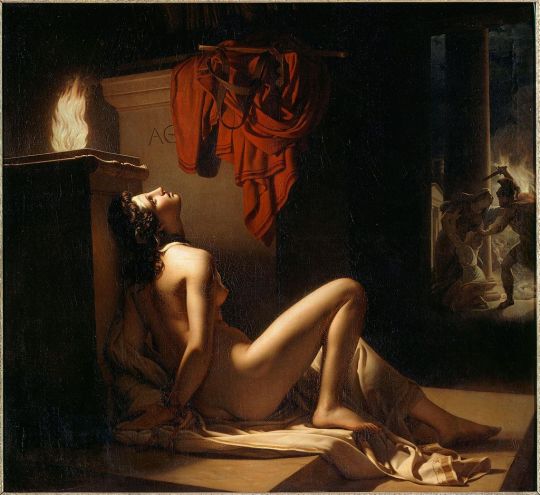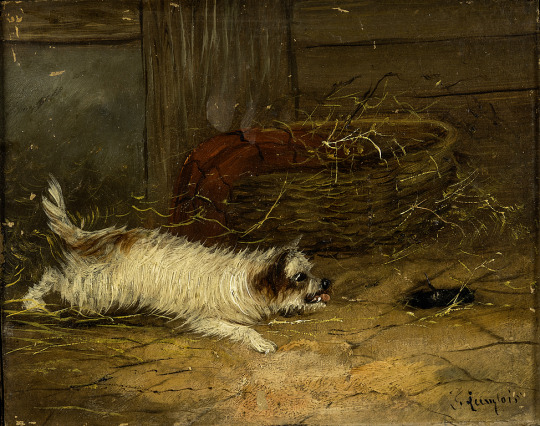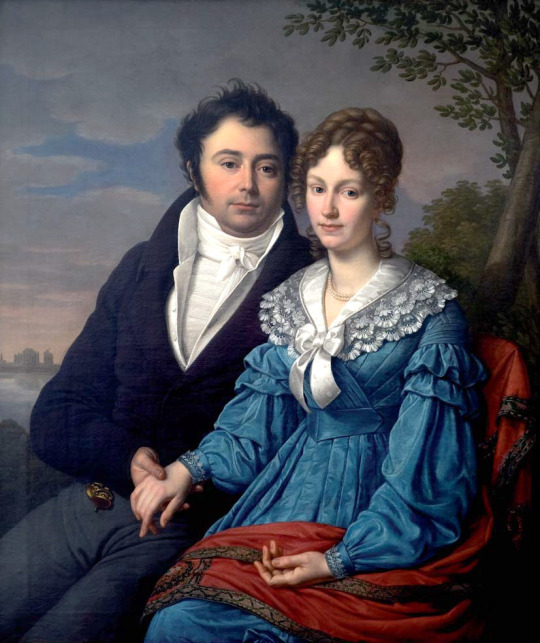#Jérôme Martin Langlois
Text

Jérôme-Martin Langlois (1779-1838)
"Cassandra Imploring The Vengeance of Minerva Against Ajax" (1810)
Oil on canvas
Neoclassical
#paintings#art#artwork#mythological painting#greek mythology#jérôme martin langlois#jerome martin langlois#oil on canvas#fine art#neoclassical#neoclassicism#french artist#female figure#female nude#portrait of a woman#side profile#violence#violent#the iliad#cassandra#1810s#early 1800s#early 19th century
418 notes
·
View notes
Text

Jérôme Martin Langlois (French, 1779-1838) - Dog and Rat
104 notes
·
View notes
Text

Cassandra Imploring the Vengeance of Minerva against Ajax
by Jérôme-Martin Langlois
#cassandra#priestess#minerva#ajax#art#the iliad#neoclassical#jérôme-martin langlois#history#europe#european#ancient#greek#greece#mythology#mythological#troy#trojan#kassandra#greek mythology
297 notes
·
View notes
Text

9 notes
·
View notes
Photo







It’s the later 1810s (from top to bottom) -
ca. 1815 Apolonia Kamińska née Sokołowska by Józef Reichan (location ?). From tumblr.com/lenkaastrelenkaa/701357046637936640 2048X2735 @72 1.5Mj.
1817 Lady by Jérôme-Martin Langlois (private collection). From tumblr.com/historical-fashion-devotee 1280X1597 @72 401kj.
ca. 1817 Heinrich Theodor Wilhelm and Catharina Jakobina Zanders by Heinrich Christoph Kolbe (private collection). From tumblr.com/fashion-history-germany 827X984 @72 268kj.
1819 Anna Pavlovna, Queen Consort of the Netherlands by Alexandre De Latour (Netherlands Royal Collection). From tumblr.com-historical-fashion-devotee; fixed spots w Pshop 1901X2339 @150 881kj.
1819 Sarah Maria Goodrich Giraud by John Wesley Jarvis (David Owsley Museum of Art - Muncie, Indiana, USA). From tumblr.com/historical-fashion-devotee; fixed spots & a few cracks w Pshop 2011X2241 @72 1.3Mj.
1817 Josefa Doubkova and her son Edward by Antonín Machek (National Gallery, Prague). From tumblr.com/historical-fashion-devotee; fixed spots & ridges w Pshop & enlarged to screen 1069X1400 @72 375kj.
Alexandra Buturlina by Nicolas de Courteille (location ?). From tinterest.com/joellefilori/tableaux-groupes/; blurred darker parts of bckgnd to fix spoys w Pshop 1430X1920 @96 639kj.
#1810s fashion#French restoration fashion#late Georgian fashion#Apolonia Kamińska#Józef Reichan#curly hair#square décolletage#long full sheer over-sleeves#waist band#Empire waistline#close skirt#Jérôme-Martin Langlois#tiara#neckline ruff#neckline bertha#mameluke sleeves#Catharina Jakobina Zanders#Heinrich Christoph Kolbe#high neckline#lapels#lace collar#pleated bertha#V waistline#Queen Anna Pavlovna#wrap#Sarah Maria Goodrich Giraud#John Wesley Jarvis#Josefa Doubkova#feathered hat#fur-trimmed coat
9 notes
·
View notes
Text
0 notes
Text

Diana and Endymion by Jérôme-Martin Langlois (1822)
#jerome-martin langlois#art#paintings#fine art#19th century#19th century art#neoclassical#neoclassicism#neoclassical art#painting#french art#french artist#mythology#roman mythology#diana#artemis#endymion#classic art
1K notes
·
View notes
Text

'Cassandra Imploring the Vengeance of Minerva against Ajax'. Jérôme-Martin Langlois. 1810.
177 notes
·
View notes
Text






Kassandra
1. the fruits by paris paloma / 2. cassandra by frederick sandys / 3. pray by the amazing devil / 4. cassandra imploring athena for revenge against ajax by jérôme martin langlois / 5. ptolemaea by ethel cain / 6. trojan women (euripides) trans. e.p. coleridge
#kassandra of troy#the iliad#the trojan war#the trojan women#web weaving#tagamemnon#cassandra of troy#having thoughts </3#fil.txt
50 notes
·
View notes
Text
the song of fury - thoughts on Homer's Iliad
spoiler alert!

"I have endured what no one on earth has ever done before – I put my lips to the hands of the man who killed my son." | "Priam at the feet of Achilles", Jérôme-Martin Langlois.
After a month, I finally finished reading the Iliad. What a book, everyone! Although it's quite a tiring read, it's very obvious why it's a classic. It's a little funny to do a spoiler alert of a 3000+ old book, but beware anyways lol.
(btw i'm once again writing this in portuguese and translating it to english, sorry for any weird wording and grammar mistakes)
The tale of this piece on time of the ninth year of the Trojan War, which opens with the beginning of Achilles' fury until the moment when it is appeased, is heartbreaking, mainly because it is such a vivid portrayal of the horrors of war. How many were the victims of that war in the 24 books of the Iliad, and how many in all the other years that the poem leaves out? It's moving in every sense, and becomes even more impactful considering the context we're living in, with two wars going on in the world.
It's necessary to point out that a large part of the reason it's such a tiring book to read is because it has such a different formula from what we're used to: because it has an oral presentation context, there are many repetitive and formulaic parts that can be hard to swallow at times. Honestly, at every battle book I had the impression that I was reading the same thing over and over within 500 pages. Interestingly, despite this, I still felt quite involved in the battles, especially those that take place after book 9. You can feel the desperation on both sides of the war emanating from the pages, as if you were there in the middle of the battle. It's an intensity that can't be explained.
Of course, you can't talk about the Iliad without mentioning its most important character: Hector. There's no greater tragedy than reading this man in battle giving his all, convinced that he was going to win the war and be able to protect his city and his family, while we know exactly what's going to happen and that there's no escaping it. There's no other way the war can go, even if we want it to. It was inevitable that Patroclus would return to battle after seeing his companions massacred and that, manipulated by the divine will, he would go after the Trojans and sign his own death warrant. It was inevitable that Hector would kill Patroclus the first chance he got, doing literally the only thing that would make Achilles return to battle and also signing his own death warrant. And of course, it's inevitable that Achilles would kill Hector after everything and that, being who he is, that wouldn't be enough to calm his anger and ease his grief. Achilles' fury was simply inevitable. You can't escape the fate given by the gods, no matter what you do.
By the way, it's worth persevering through the fatigue that can take you up to book 15 precisely because, from book 16 onwards, it's simply impossible to stop reading. The battle around Sarpedon's body, then the chase to Troy, Patroclus' battle with Hector, the battle around Patroclus' body. Girl, you can't put the book down, I swear! From that point on, I just couldn't stop reading or crying. It was much worse to read Achilles' reaction to learning of his companion's death than it was to read Patroclus' death itself. The rage is suddenly not just rage, but the pain so deep and so suffocating of losing the person you love most in the world. Achilles knows he's going to die after killing Hector, but it doesn't matter anymore. The only thing that matters is avenging Patroclus, whatever the cost.
The sad thing is that Hector doesn't know what fate has in store for him. Hector doesn't know that he has just planted the seed of his own death. It's horrible to read the chase around Troy, it's horrible to read Athena deceiving Hector. Imagine you're about to die in battle because you know you can't face the storm that is the guy who wants to kill you, and then you have a quick hope that you'll survive because your brother has come to your rescue. Except he didn't, it was a goddess making you believe he did so that her will would be done. Absolutely horrible! I don't even know if I need to comment that all I could think about was the scene in book 6 where he meets his wife and little boy. Literally the last time they see each other, and neither of them knows it.
The thing is, Iliad is a sad book. It's refreshing and funny and exciting, but above all it's a sad book. And that's what interesting about it's ending, because it is still sad, even if in nature its hopeful. Priam goes to beg Achilles for his son's body and Achilles, deeply moved by him, agrees. The fury meets its end and merciless Achilles finds in himself to have mercy of this old man who could have been his father, because it will be his father right in the next year, grieving the child lost in battle. Hector can finally rest, an ending to all that death and all that pain we read for 24 books.
Except it isn't. Troy will still fall, fathers will still lose their lives, wives and kids will either meet their death or be forced into slavery. Priam's city will be lost forever, we just don't see it here. So, just like the trojans, we're allowed this brief moment of peace, though we both know it will end soon.
After a month digesting this book, I can't say anything other than how marvellous it is, the kind of book everyone should read at least once in their lives. I have to say, though, that there's still a bitter taste left in my mouth after reading this one because, as I said before, its harder to read it while we're living two major wars in the world right now. I just hope that this book story remains just a book story and we can see a different outcome in real life. We have to. Unlike in Iliad where fate is woven by gods, this is a man-made horror. We can put an end to it.
#books of 2024#gia reads#feb 2024#homers iliad#the iliad#bookblr#readerblr#readers of tumblr#books and reading#classic books
3 notes
·
View notes
Text
Endymion and his sopor aeternus
Selene, the Titan goddess of the moon, loved the mortal Endymion. She found Endymion so beautiful that she asked Zeus to grant him eternal youth. Alternatively, Selene so loved how Endymion looked when he was asleep in the cave on Mount Latmus, near Miletus in Caria, that she entreated Zeus that he might remain that way. In some versions, Zeus wanted to punish Endymion for daring to show romantic interest in Hera. Whatever the case, Zeus granted Selene's wish and put Endymion into an eternal sleep. Every night, Selene visited him where he slept, and by him had fifty daughters.
According to a passage in the Deipnosophistae, the sophist and dithyrambic poet Licymnius of Chios told a different tale, in which Hypnos, the god of sleep, loves Endymion and does not close the eyes of his beloved even while he is asleep, but lulls him to rest with eyes wide open so that he may without interruption enjoy the pleasure of gazing at them.

Diana and Endymion by Jérôme-Martin Langlois, circa 1822
5 notes
·
View notes
Video
Michel Ney, duc d'Elchingen, prince de La Moskowa, Maréchal de France (1769-1815) d'après un portrait de Jérôme-Martin Langlois (1779-1838) par Athèna
Via Flickr :
Michel Ney, duc d'Elchingen, prince de La Moskowa, Maréchal de France (1769-1815) d'après un portrait de Jérôme-Martin Langlois (1779-1838) (XIXème siècle, Musée National du Château de Versailles, Versailles) d'Eugène Battaille (1817-1882)
0 notes
Text

La ville d’Amiens demande à Madonna si elle peut emprunter son tableau de Diane et Endymion
Mme Brigitte Fouré maire d'Amiens, a demandé à Madonna si la ville pouvait emprunter un tableau que l'on croyait avoir été détruit.
L'œuvre - Diane et Endymion de Jérôme-Martin Langlois - a été exposée à partir de 1878 mais a disparu pendant la Première Guerre mondiale.
Madame la maire pense désormais que la célèbre pop star américaine en est propriétaire.
Elle a déclaré que l'exposition des œuvres d'art aiderait la ville à devenir la capitale européenne de la culture en 2028.
Diane et Endymion a été commandée par le roi Louis XVIII pour une salle du château de Versailles et a été achetée par l'État en 1873.
Mme Fouré a déclaré que le tableau avait probablement été prêté au musée d'Amiens par le Louvre à Paris avant le début de la guerre.
Le journal Le Figaro a rapporté que le tableau - ou un tableau presque identique - avait été acheté lors d'une vente aux enchères à New York en 1989 par Madonna elle-même pour 1,3 million de dollars (1,1 million d'euros).
"J'aimerais qu'à cette occasion vous puissiez nous prêter votre tableau pour que les habitants puissent redécouvrir ce travail et en profiter", a déclaré Mme Fouré dans une vidéo publiée sur Facebook.
1 note
·
View note
Text
0 notes
Text
Le maire d'Amiens, dans le nord de la France, a demandé à Madonna de prêter l'un des tableaux de sa collection à la ville, arguant qu'il aurait pu y avoir été volé pendant la Première Guerre mondiale."Madonna, vous n'avez probablement pas entendu parler d'Amiens... mais il y a un lien particulier entre vous et notre ville." Brigitte Fouré l'a revendiqué dans une adresse vidéo à la reine de la pop, qu'elle a publiée lundi sur Facebook.
La peinture du XIXe siècle "Diana et Endymion", que l'on croit être de l'artiste français Jérôme-Martin Langlois et qui appartient maintenant à Madonna, « est probablement une œuvre qui a été prêtée au musée d'Amiens par le Louvre avant la première guerre mondiale après quoi on en a perdu la trace », dit-elle.Foure a souligné que les autorités de la ville "ne conteste en aucune manière l'acquisition légale" de l'oeuvre de Madonna. Au lieu de cela, elle voulait que le chanteur "prêter" la peinture à Amiens, expliquant qu'elle renforcerait une candidature de la ville de 135 000 habitants pour devenir Capitale européenne de la culture en 2028.« Diane et Endymion » avait été exposée dans l'un des musées d'Amiens entre 1878 et 1918. Mais elle a disparu lors du bombardement intensif de la ville par les forces allemandes cette année-là et aurait été volée ou détruite.La peinture a de nouveau fait la une des journaux plus tôt ce mois-ci après que le journal Le Figaro a publié un article suggérant que l'œuvre en question aurait pu appartenir à Madonna.La pop star américaine aurait payé 1,3 million de dollars pour "Diana et Endymion" lors de la vente aux enchères de Sotheby's à New York en 1989.L'achat est passé inaperçu en France à cette époque, mais en 2015, un conservateur d'Amiens a repéré ce qu'il pensait être l'œuvre de Langlois en arrière-plan d'une photo de Madonna chez elle publiée dans le magazine Paris Match, selon Le Figaro.
LIRE LA SUITE:
Madonna s'en prend à Instagram pour "libérer le mamelon"
Pendant ce temps, il n'y a aucune certitude quant à l'authenticité de la peinture détenue par Madonna car elle serait plus courte de trois centimètres que l'original et dépourvue de la signature de l'artiste. Le Louvre, qui a exposé la pièce en 1988, a suggéré qu'il s'agissait "presque certainement une copie, très probablement par l'artiste lui-même."Foure a dit que cela lui importait peu si c'était une copie car c'était toujours "extrêmement similaire" à la peinture originale. "J'aimerais que les Amiens puissent le revoir" elle a insisté. Madonna n'a pas encore répondu à la demande du maire.
Vous pouvez partager cette histoire sur les réseaux sociaux :
Suivez RT sur
0 notes